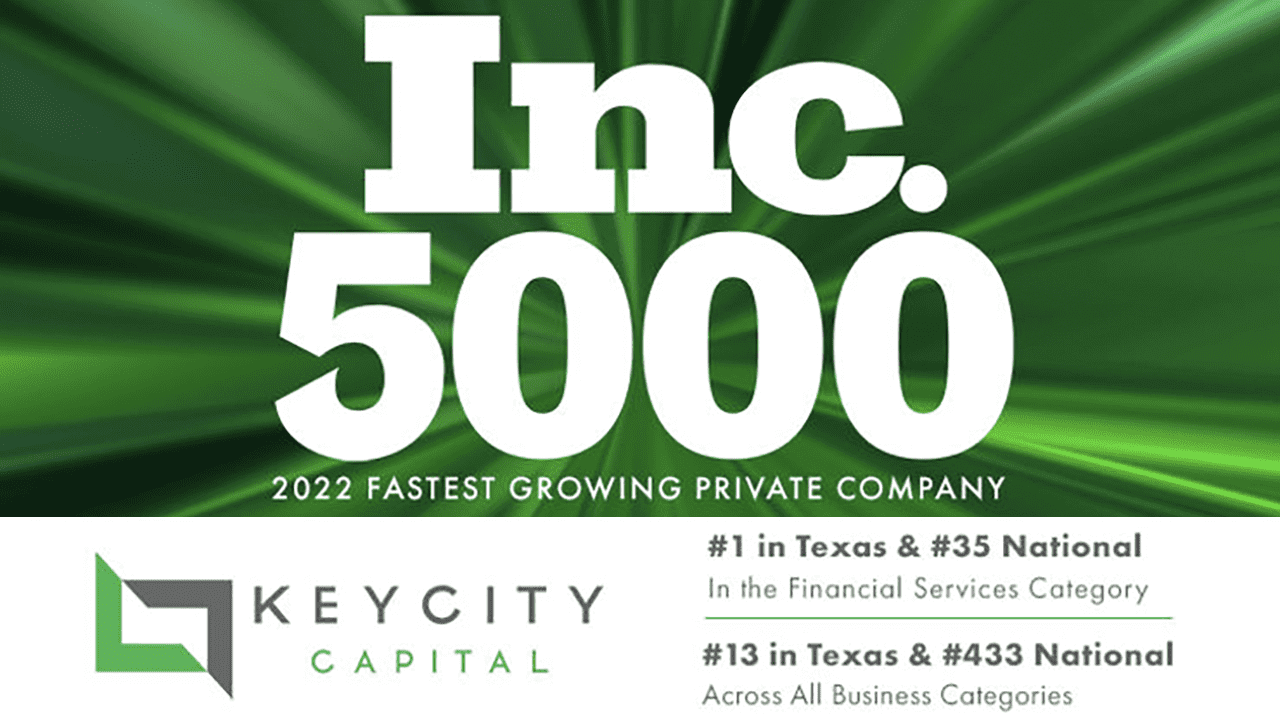

Company News
August 18, 2022
KeyCity Capital announced today it has been included on Inc. Magazine’s prestigious Inc. 5000 2022 list of the fastest growing private companies in America. The DFW-area investment firm comes in at #1 in Texas and...

Multimedia
August 27, 2024
In this insightful interview, Tie Lasater, CEO of KeyCity Capital, joins Hugh Hewitt on The Hugh Hewitt Show to discuss critical issues affecting the housing market, including rising interest rates, apartment vacancies, and the changing...

Multimedia
August 16, 2024
In this enlightening conversation, Stephen Patterson, Chief Client Officer of KeyCity Capital, joins Hugh Hewitt on The Hugh Hewitt Show to discuss how investing in rental properties in the Sun Belt can provide lucrative opportunities...

Blog Posts
August 15, 2024
It’s been almost a year since the last increase in interest rate by the Fed. Inflation was moving at an unsustainable pace and the labor market was red hot. By all standards, the economy was...

Multimedia
July 31, 2024
In this insightful interview, Tie Lasater, CEO of KeyCity Capital, joins Hugh Hewitt on The Hugh Hewitt Show to discuss a troubling CNN report revealing that 90% of renters want to buy a home but...

Multimedia
July 11, 2024
In this insightful interview, Tie Lasater, CEO of KeyCity Capital, joins Sebastian Gorka on America First to discuss important financial strategies for 2024. Topics covered include: The current housing market trends and how they are...

Multimedia
July 10, 2024
In this informative interview, Stephen Patterson, Chief Client Officer at KeyCity Capital, joins Hugh Hewitt on The Hugh Hewitt Show to discuss critical financial topics, including: The current housing market trends and what’s driving changes...

Multimedia
June 25, 2024
In this insightful interview, Tie Lasater, CEO of KeyCity Capital, joins Hugh Hewitt on The Hugh Hewitt Show to explore how diversifying your investment portfolio with real estate can offer stability and long-term growth. Key...

Multimedia
June 12, 2024
In this insightful conversation, Stephen Patterson, Chief Client Officer at KeyCity Capital, joins Hugh Hewitt on The Hugh Hewitt Show to discuss the latest trends in the housing market, based on a Building Design and...

Multimedia
June 6, 2024
In this compelling interview, Stephen Patterson, Chief Client Officer at KeyCity Capital, joins Sebastian Gorka on the America First radio show to discuss the effects of 'Bidenomics' on the housing market and broader investment strategies....
Set up a meeting with a member of the KeyCity Capital team to get started.
**Disclaimer FOR ACCREDITED INVESTORS ONLY WRITTEN PROOF OF ACCREDITED INVESTOR STATUS MUST BE PROVIDED An accredited investor, in the context of a natural person, includes anyone who: • earned income that exceeded $200,000 (or $300,000 together with a spouse or spousal equivalent) in each of the prior two years, and reasonably expects the same for the current year, • has a net worth over $1 million, either alone or together with a spouse or spousal equivalent (excluding the value of the person’s primary residence), OR • holds in good standing a series 7, 65 or 82 license with a registered broker dealer. On the income test, the person must satisfy the thresholds for the three years consistently either alone or with a spouse or spousal equivalent, and cannot, for example, satisfy one year based on individual income and the next two years based on joint income with a spouse or spousal equivalent. The only exception is if a person is married within this period, in which case the person may satisfy the threshold on the basis of joint income for the years during which the person was married and on the basis of individual income for the other years. In addition, entities such as banks, partnerships, corporations, limited liability companies and nonprofits must satisfy their own accredited investor criteria. Of the entities that would be considered accredited investors and depending on your circumstances, the following may be relevant to you: • any trust, with total assets in excess of $5 million, not formed specifically to purchase the subject securities, whose purchase is directed by a “sophisticated person.” In this context, a “sophisticated person” means the person must have, or the company or private fund offering the securities reasonably believes that this person has, sufficient knowledge and experience in financial and business matters to evaluate the merits and risks of the prospective investment. • Any entity in which all of the equity owners are accredited investors. Source: Investor.gov